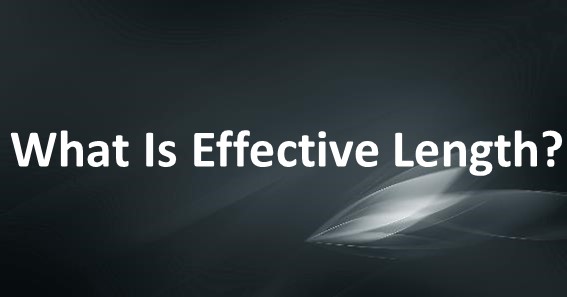Are you curious to know what is effective length? You have come to the right place as I am going to tell you everything about effective length in a very simple explanation. Without further discussion let’s begin to know what is effective length?
In the realm of structural engineering, understanding the behavior of different structural elements is crucial for designing safe and efficient structures. One fundamental concept that plays a significant role in the design process is effective length. In this blog post, we will delve into the concept of effective length, its significance in structural analysis, and how it influences the stability and strength of structural members. Join us as we demystify effective length and explore its importance in the world of structural engineering.
What Is Effective Length?
Effective length refers to a parameter used in structural analysis to determine the behavior of structural members under various loading conditions. It is a measure of the effective unsupported length of a member that experiences lateral buckling or deformation due to compressive forces.
Understanding The Importance Of Effective Length:
- Buckling and Stability: Members subjected to compressive forces are prone to buckling, which can lead to structural failure. Effective length helps assess the stability of a member and its ability to resist buckling. By considering effective length, engineers can design structures that are stable and capable of withstanding the applied loads.
- Column Design: Effective length is particularly crucial in column design, as columns are primarily subjected to compressive forces. Determining the effective length allows engineers to assess the column’s stability and design it to withstand buckling and axial loads effectively.
- Critical Load: The effective length of a member affects its critical load, which is the maximum load that the member can carry without buckling. By considering the effective length, engineers can calculate the critical load and ensure that the member is designed to handle loads safely.
Factors Affecting Effective Length:
- Boundary Conditions: The effective length of a member is influenced by its boundary conditions, which determine the degree of restraint at its ends. Different boundary conditions, such as fixed, pinned, or free, affect how the member responds to compressive forces and lateral deformation.
- Support Conditions: The type of support provided to a member also affects its effective length. Members with fixed or rigid supports have shorter effective lengths compared to members with flexible or hinged supports.
- Geometric Configuration: The shape and geometry of the member can impact its effective length. For example, slender members with larger aspect ratios (length-to-width ratios) tend to have longer effective lengths and are more susceptible to buckling.
Determining Effective Length:
- Analytical Methods: Effective length can be determined using various analytical methods, such as Euler’s buckling theory, which provides approximate formulas based on the member’s geometry and support conditions.
- Finite Element Analysis (FEA): Advanced computational methods, such as finite element analysis, can be used to determine the effective length of complex structures accurately. FEA allows for a detailed analysis of the behavior of structural members under different loading conditions.
Conclusion:
Effective length is a crucial parameter in structural engineering that helps engineers analyze and design safe and stable structures. By considering the effective length of members, engineers can assess their buckling behavior, determine critical loads, and ensure the overall structural integrity of the project. Understanding the concept of effective length empowers structural engineers to make informed decisions during the design process, leading to structures that can withstand applied loads, provide stability, and ensure the safety of occupants. So, embrace the importance of effective length in structural analysis and design, and embark on a journey to create robust and resilient structures.
FAQ
What Is Called Effective Length In Steel?
The effective length is the length between points of inflection (points of zero bending moment) on the buckled shape.
What Is Meant By Effective Length Of Beam?
d = effective depth of beam or slab. The effective span for a simply supported slab is equal to the clear span between the supports (i.e. the length up to the face of support) plus effective depth or width of the slab.
What Is Meant By Effective Length In Rcc?
The effective column length can be defined as the length of an equivalent pin-ended column having the same load-carrying capacity as the member under consideration. The smaller the effective length of a particular column,the smaller its danger of lateral buckling and the greater its load carrying capacity.
What Is Effective Length In Building?
Effective length is a critical concept in Structural Design for all structural members such as Steel UC and UB sections, reinforced concrete columns and scaffold tubes. Its technical definition is ‘the length of a component which is effectively restrained’.
I Have Covered All The Following Queries And Topics In The Above Article
What Is Effective Length Of Column
What Is Effective Focal Length
What Is The Effective Length Of A Seconds Pendulum
What Is The Effective Length Of Seconds Pendulum
What Is The Effective Length Of A Column At Both Ends Fixed?
What Is The Effective Length Of Column
What Is Effective Length In Physics
What Is Effective Length In Civil Engineering
What Is Effective Length Formula
What Is Effective Length Of Column
Effective Length Formula
What Is Effective Length Of Simple Pendulum
What Is Effective Length Of Beam
What Is Effective Length Of Magnet
What Is Effective Length
What does effective length mean
What is effective length?



